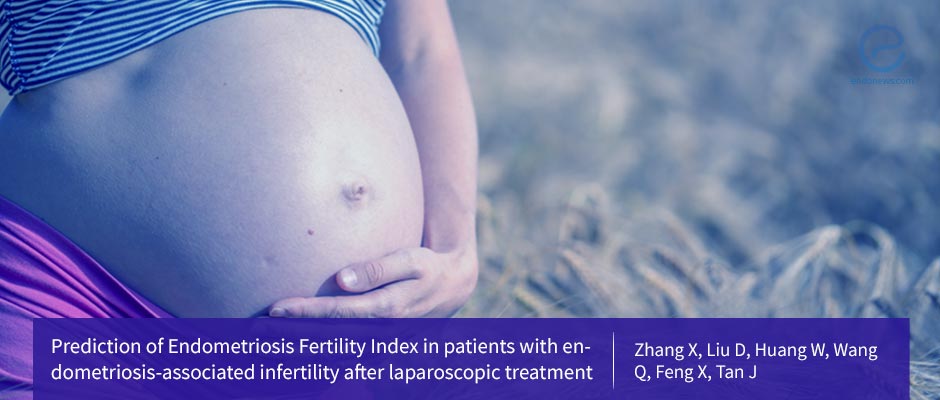Is the Endometriosis Fertility Index Reliable?
May 21, 2018
This paper confirms the reliability of the Endometriosis Fertility Index in predicting spontaneous pregnancies in women suffering from endometriosis-related infertility who have undergone laparoscopy.
Key Points
Highlights:
- The authors of this study wished to analyze the predictive value of the Endometriosis Fertility Index (EFI), which is responsible for predicting spontaneous conception post-surgery. The researchers looked specifically at Chinese women suffering from endometriosis-related infertility.
Importance:
- Researchers have yet to elucidate the link between endometriosis and infertility.
- Surgery for the treatment of endometriosis-related infertility has not yielded great pregnancy results with the current staging system that is used.
What’s done here:
- The participants included in the study were women who were suffering from endometriosis-associated infertility. These women were undergoing laparoscopic treatment as well. These women had normal ovulation, one or more patent tube, and had not conceived in a 12-month period.
- All participants underwent surgery. The researchers collected historical and surgical data, these were combined to yield the EFI scores.
- The researchers followed up with the patients for 36 months, unless the patient got pregnant. Then the follow-up period extended to the date of delivery.
- The data from this study was subject to statistical analysis.
- The researchers calculated the Cumulative pregnancy incidence (CPI) according to the EFI scores by using the life table method and Kaplan–Meier survival curve analyses.
- Differences between EFI groups were analyzed using the log-rank test.
- The researchers determined the optimal cut-off point for pregnancy prediction by looking at the plotted receiver operating characteristic curves.
Key results:
- There were 1097 participants who were successfully interviewed over the course of this study. Of those patients, 505 participants conceived a child naturally.
- The researchers found that the differences in CPI among the following EFI scores were significant and the difference in CPI increased as the EFI score increased:
- 10
- 7-9
- 4-6
- 2-3
- The authors noted that the optimal cut off point was 7.5 with an associated sensitivity of 68.51% and specificity of 52.20%.
- Overall, the researchers highlighted the value provided by the EFI score in determining spontaneous pregnancy, specifically in women who suffer from endometriosis-associated infertility and were treated by laparoscopy.
Limitations of the study:
- The author makes note of some confounding factors including:
- Different surgeons
- Different medications administered after surgery
- The author also points out the fact that this is a retrospective study but the data needed for the EFI calculations were collected prospectively.
Lay Summary
Zhang et al. recently published a paper titled “Prediction of Endometriosis Fertility Index in patients with endometriosis-associated infertility after laparoscopic treatment” in Reproductive BioMedicine Online. The research group from the West China Second University Hospital in Sichuan University wanted to analyze the Endometriosis Fertility Index (EFI) and its predictive value. The main function of the EFI is to predict spontaneous conception after surgery.
The researchers recruited women with endometriosis-related infertility who were undergoing laparoscopic treatment. These women underwent surgery and the researchers collected their historical and surgical data. This data was then used to calculate the EFI score. The researchers did follow up with the participants to talk about post-operative outcomes, like pregnancies. The data from this study was subject to statistical analysis. The life table method and Kaplan–Meier survival curve analyses were used to yield Cumulative pregnancy incidence (CPI) among the EFI scores. The researchers also utilized the log-rank test in order to analyze differences between the EFI groups. A number of plotted receiver operating characteristic curves were used to determine the optimal cut-off point in terms of pregnancy prediction.
The researchers found that 46.03% of the participants conceived a child naturally. 10, 7-9, 4-6, and 2-3 were the differences in CPI with regards to EFI scores that were statistically significant and the researchers also found that an increased EFI score corresponded to an increased CPI. The optimal cut-off point in terms of pregnancy prediction was found to be 7.5. In short, the researchers demonstrated the value in using an EFI score to predict spontaneous pregnancy in women with endometriosis-related infertility who have undergone treatment by laparoscopy for that condition.
Research Source: https://www.ncbi.nlm.nih.gov/pubmed/29628331
Endometriosis Fertility Index Laparoscopy Pregnancy infertility

